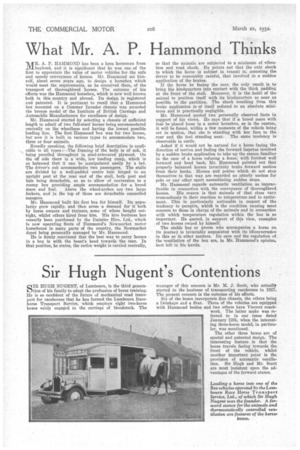What Mr. A. P. Hammond Thinks R. A. P. HAMMOND
Page 52

If you've noticed an error in this article please click here to report it so we can fix it.
has been a keen horseman from 1V_Lboyhood, and it is significant that he was one of the first to appreciate the value of motor vehicles for the safe and speedy conveyance of horses. Mr. Hammond set himself, about seven years ago, to design a horsebox which would meet the requirements, as he conceived them, of the transport of thoroughbred horses. The outcome of his efforts was the Hammond horsebox, which is now well known both in this country and abroad. Its design is registered and patented. It is pertinent to recall that a Hammond box mounted on a Commer Invader chassis was awarded the bronze medal of the Institute of British Carriage and Automobile Manufacturers for excellence of design.
Mr. Hammond started by selecting a chassis of sufficient length te admit of two full-sized horses being accommodated centrally on the wheelbase and having the lowest possible loading line. The first Hammond box was for two horses, but now it is built in various types to accommodate two, three or four animals.
Broadly speaking, the following brief description is applicable to all types :—The framing of the body is of ash, it being panelled throughout in steel-armoured plywood. On The off side there is a wide, low loading ramp, which is so balanced that it can be manipulated easily by a lad. The driver's cab accommodates two passengers. The stalls nre divided by a well-padded centre bale hinged to an upright post at the rear end of the stall, both post and bale being detachable, so as to allow of conversion to a roomy, box providing ample accommodation for a brood mare and foal. Above the wheel-arches are two large lockers, and in the top of those are detachable enamelled mangers. •
Mr. Hammond built his -first box for himself. Its popularity grew rapidly, and then arose a demand for it both by horse owners and trainers, some of whom bought outright, whilst others hired from him. His hire business has recently been purchased by the Daimler Hire, Ltd., which Is now operating fleets of Hammond's Newmarket motor horseboxes in many parts of the country, the Newmarket depot being personally managed by VIr. Hammond.
He is firmly convinced that the best way to carry horses in a box is with the beast's head towards the rear. In that position, he states, the entire weight is carried centrally, so that the animals are subjected to a minimum of vibration and road shock. He points out that the only shock to which the horse is subjeot in transit is, assuming the driver to be reasonably careful, that involved in a sudden application of the brakes. If the horse be facing the rear, the only result is to bring his hindquarters into contact with the thick padding at the front of the stall. Moreover, it is the habit of the animal to position itself with its hindquarters as near as possible to the partition. The shock resulting from this brake application is of itself reduced to an absolute minimum and is practically negligible.
Mr. Hammond quoted two personally observed facts in support of his views. He says that if a brood mare with foal be placed loose in a motor horsebox, as is the custom, it will be found, within a few moments of the vehicle being set in motion, that she is standing with her face to the rear and the foal standing near. The same tendency is observable in cattle.
Asked if it would not be natural for a horse facing the direction of motion and feeling the forward impetus involved by a sudden brake application to take up the stance familiar in the case of a horse refusing a fence; with forefeet well forward and head back, Mr. Hammond pointed out that properly balanced horses invariably brake forward motion from their hocks. Horses and ponies which do not stop themselves in that way are regarded as utterly useless for polo or any other sport necessitating sudden stops.
Mr. Hammond regards automatic ventilation as impracticable in connection with the conveyance of thoroughbred
horses. His reason is that animals of that class vary tremendously in their reaction to temperature and to excitement. This is particularly noticeable in respect of the tendency to perspire which is the condition causing most concern to those in charge of the animals and in connection with which temperature regulation within the box is so important. He quoted, in support of this view, examples of two horses owned by himself.
The stable boy or groom who accompanies a horse on its journey is invariably acquainted with its idiosyncrasies in this as in other matters. Its care and the regulation of the ventilation of the box are, in Mr. Hammond's opinion, best left in his hands.




































































































